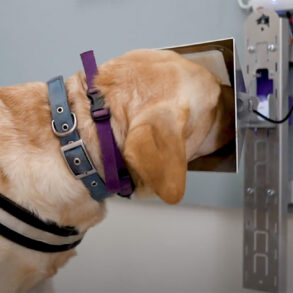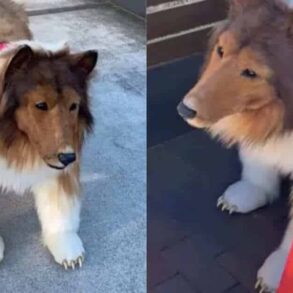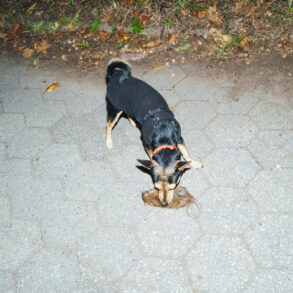There’s no question that we are living in an era where dogs are deified—treated less as pets and more as family members. If further proof were needed, look no further than the recently opened ‘Architecture for Dogs’ exhibition at Milan’s ADI Design Museum, running until 16 February 2025. First presented at Design Miami in 2012 and following a successful European showcase in London in 2020, this latest edition features canine architecture by design luminaries such as Shigeru Ban, Toyo Ito, Konstantin Grcic, and Kengo Kuma, underscoring the growing cultural fascination with our four-legged companions.
Designed with specific breeds in mind and displayed on a series of curated islands, the pieces range from the practical to the fantastical. Shigeru Ban, for instance, crafted an undulating maze and bed for a Papillon (or Continental Toy Spaniel) using ubiquitous cardboard tubes, while Reiser + Umemoto created a cloud-like orange coat tailored for a Chihuahua. Even Giorgio Armani makes an appearance, with a dog-focused capsule collection designed in collaboration with Poldo Dog Couture.

The exhibition layout, curated by Kenya Hara and the Hara Design Institute, is designed as a fluid arrangement of display islands
(Image credit: Courtesy of ADI Design Museum. Photography by Denise Manzi)
Curated by Kenya Hara – CEO of Nippon Design Center and artistic director of Muji – the showcase challenges conventional perceptions of pet architecture. ‘Dogs are an integral part of many households, but their needs are often met with functional, mass-produced solutions that lack consideration for individuality and emotional connection,’ explains museum director Andrea Cancellato. ‘This project invites world-class architects to reimagine this bond, creating pieces that are as much about enhancing the dog’s environment as they are about celebrating the human-canine relationship.’
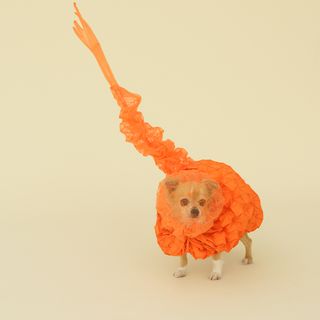



NYC firm Reiser + Umemoto designed ‘The Cloud’ as a ‘second skin’ for a chihuahua, creating a ‘climatic buffer’ to shield the dog from cold, and providing protection for the general weakness of the breed’s bones
(Image credit: Courtesy of ADI Design Museum. Photography by Hiroshi Yoda.)
To mark the show’s Italian debut, two new contributions by Giulio Iacchetti and Piero Lissoni have been added to the line-up. Working with sustainable design brand Riva 1920, Iacchetti designed a round, plywood-panelled structure for an Italian Greyhound that recalls a Roman camp tent.
‘I designed the kennel as a small, self-contained piece of architecture, simply scaled down,’ Iacchetti told Wallpaper*. ‘A key aspect was the ability to construct it starting from flat elements. The result is an elegant pavilion that harmonises beautifully with the sinuous and enchanting lines of the Italian Greyhound.’




Lissoni’s cave-like plywood and aluminium kennel for a yorkiepoo takes inspiration from an airport hangar
(Image credit: Courtesy of ADI Design Museum. Photography by Hiroshi Yoda.)
Meanwhile, Lissoni’s plywood and aluminium kennel for a Yorkiepoo takes inspiration from an airport hangar. ‘The hangar is the primeval cave,’ Lissoni explains. ‘It’s the form we used as a home when we were animals, when we were evolving apes. I reimagined the idea of the cave as an architectural model, thinking that animals – this time, four-legged ones – could use this hangar, my technological cave.”
What sets ‘Architecture for Dogs’ apart is its participatory nature: blueprints for all the designs can be downloaded for free from the official website, inviting people worldwide to construct and customise the designs for their pets.
We spoke with ADI President Luciano Galimberti and museum director Andrea Cancellato to learn more about the exhibition’s deeper values and why Milan provides such a receptive context for ‘Architecture for Dogs’.
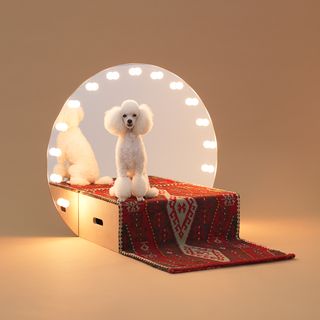



Konstantin Grcic’s bed for a toy poodle draws inspiration from claims by poodle owners that their pets respond positively to mirrors, exhibiting clear signs of self-awareness
(Image credit: Courtesy of ADI Design Museum. Photography by Hiroshi Yoda.)
Wallpaper*: ADI is one of the few museums in Milan—and across Italy—that allows dogs into its exhibition spaces. What do you think this adds to the museum experience?
Luciano Galimberti: The museum gallery, the main corridor connecting all the exhibition rooms, also functions as a public thoroughfare, linking two parts of the city. When redeveloping the industrial site that became the museum, we decided to retain this urban role, fostering cultural, social, and spatial openness.
Since its inauguration, the museum has become a vibrant hub of city life, hosting exhibitions, events, workshops, and more. It welcomes people of all ages—cyclists, wheelchair users, and dog walkers among them. Guided by Design for All principles, we embraced the inclusion of pets to reflect a clear societal trend. Italy has around 15 million pets, and in Milan, one in two residents shares their home with a companion animal.




Shigeru Ban’s undulating maze and bed for a papillon (or continental toy spaniel) is made by connecting everyday cardboard tubes
(Image credit: Courtesy of ADI Design Museum. Photography by Hiroshi Yoda.)
These pieces aren’t purely functional; they encourage humans to rethink their role as caretakers and collaborators with another species.
Andrea Cancellato, Director of ADI Design Museum
W*: Some critics suggest that designing for dogs in this way anthropomorphises their needs. How would you respond?
Andrea Cancellato: ‘Architecture for Dogs’ isn’t just about creating ‘necessary’ items – it’s about exploring the joy and meaning behind design. These pieces aren’t purely functional; they encourage humans to rethink their role as caretakers and collaborators with another species. The designs consider dogs’ physical and psychological needs – like burrowing, perching, or observing – while engaging owners in the process of building and customising the structures. This dual approach creates a shared experience and strengthens the emotional bond between humans and dogs.




Kazuyo Sejima’s dog bed for a bichon frise pays homage to the breed’s distinctive, soft white fur
(Image credit: Courtesy of ADI Design Museum. Photography by Hiroshi Yoda.)
W*: The exhibition’s free blueprints are a unique feature. How does this change how people engage with design?
AC: By offering free blueprints, Architecture for Dogs democratises access to design, turning it into a hands-on activity rather than something meant only for viewing. This participatory approach challenges the idea that architecture is for experts or human purposes alone.
W*: Having exhibited across the globe, and now Italy, have you observed differences in how these cultures approach design for dogs?
AC: Each culture brings unique perspectives. Italy, with its deep design heritage and love for craftsmanship, has embraced the project as a celebration of artistry and cultural expression. The Italian iteration emphasises natural materials and vibrant aesthetics that resonate locally, while maintaining functionality and enjoyment for the dogs. It also adds a dialogue about how design can enhance both urban living and traditional lifestyles.
TOPICS
This post was originally published on this site be sure to check out more of their content.


















